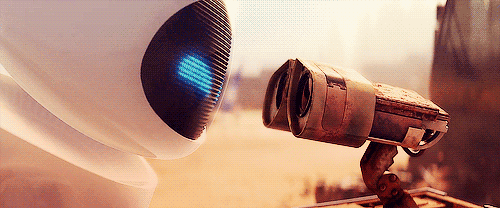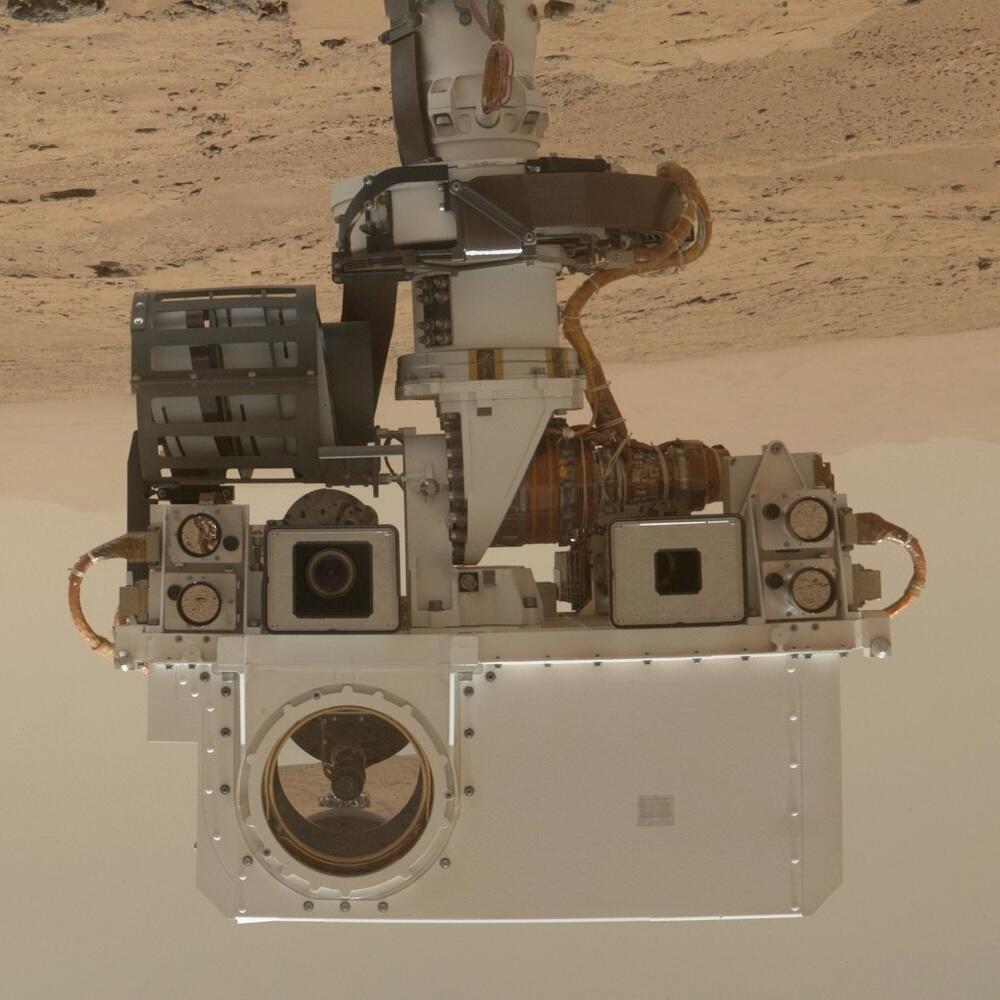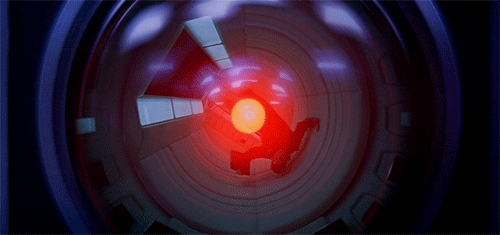 ABOUT THE AUTHOR:
ABOUT THE AUTHOR:
Sara Clayton is a junior at the University of Southern California studying public relations with double minors in web technologies and mobile app development.

It seems that mankind has been portrayed as always having been at odds with artificial intelligence, or AI.
Take the sci-fi film I, Robot: Del Spooner (Will Smith) lives in a Chicago suburb in a future where anthropomorphic AI robots are used as servants for public services. Most people in this era find these robots to be very helpful. However, after having had a scarring run-in with one of these servant robots, Spooner begins to trust them as a whole and despise the advancement of technology. Predictably enough, as the story progresses, Spooner finds out that he’s indeed onto something malevolent: the robots are becoming increasingly intelligence and are congregating en masse, eventually holding a robot uprising.
But the portrayal of artificial intelligence that Hollywood presents to movie goers is greatly exaggerated. Nevertheless, these unrealistic depictions have undoubtedly played a part in how many people perceive and visualize the concept of AI. But artificial intelligence, in reality, is not nearly as advanced or extreme as Hollywood packages it to be. In fact, artificial intelligence has done much more good than harm in real world applications, though this may not be obvious to those who use the term “artificial intelligence” interchangeably with “robots.”

It’s true that AI can take the shape of a WALL-E-esque bot, but artificial intelligence is specifically a branch of computer science that deals with the simulation of intelligence or human-like thinking and behavior. And, like humans, AI is able to improve upon itself, learning as it goes, which makes I, Robot semi-plausible.
Take the ubiquitous search engine, Google, for instance. Using AI software, Google can index billions of websites and, with just a few key words, understand what the user is looking for. Sites like Amazon and eBay also need AI in order to spit out recommendations for each unique user based on search history and past purchases. Even Siri, the iPhone’s internal Ask Jeeves, uses an AI-based voice interface program.
“Though humans and AI have their own imperfections, they also have their own unsurpassed qualities and skills that, when brought together for space exploration and experiments, lead to less mistakes and more innovation.”
But in this past decade, as more developments are being made in the realm of AI, more and more attention has been directed toward using AI autonomously in space missions. This is not a new concept. In 1998, Deep Space 1 (DS-1), a spacecraft of the NASA New Millennium Program, was the first of its kind to truly rely on AI. Only working with limited communication from ground control, DS-1 did most of the work independently, steering itself with Autonomous Navigation and thinking for itself with a Remote Agent, a computer program that helps to control the spacecraft (Muscettola, 4-5). A more recent example of AI includes the Curiosity spacecraft, which heeds advice from ground control but, for the most part, does everything else on its own, from taking photos to (cautiously) exploring and getting a feel for the alien terrain.

But as AI gets more sophisticated, will human space exploration be rendered obsolete in the near future? Sure, it might seem more cost-effective and more efficient to rely solely on AI-based automatons, but humans still have the upper hand in many ways. Contrary to the popular belief that AI can have a mind of its own, AI can only be as intelligent as the person(s) inputting its code and data. It’s true that AI robots and spacecrafts can catch more errors than a human, but it’s just as true that these apparatuses will overlook a small rock that might be of significance under human scrutiny.
Though humans and AI have their own imperfections, they also have their own unsurpassed qualities and skills that, when brought together for space exploration and experiments, lead to less mistakes and more innovation. The general public must cast off its perceived stigma of AI because cooperation between humans and robots is vital in order to most precisely, flawlessly, and successfully gather information from missions and explorations. In particular, AI is requisite in missions to Mars, both for informational and psychological needs, as they slowly pave the way for the day when humans will set foot on the red planet.
“When it comes to space exploration, partaking in such a risky journey is both a sacrifice and a reward in and of itself.”
People have always been fascinated by Mars. Even before Apollo 11 landed on the moon, books such as Journey to Mars (1894) and Edison’s Conquest of Mars (1898) have fantasized about the possibility of finding pre-existing life forms or even a Martian civilization on the planet shrouded in mystery. Aside from its prominent reddish tint, Mars is made all the more intriguing because it has roughly the same amount of land surface area as Earth, a comparable tilt in its rotational axises, and strong historic evidence of similar changes in climate, among other similarities. Mars is also the most accessible planet beyond the Earth-Moon system, and Mars’s similarities with Earth support the belief that sustained human presence is possible.

Of course, human exploration of Mars is no simple task. It is a commitment that a person must whole-heartedly make, as the trip will require at least several years away from Earth, not to mention, there’s no guarantee of a safe return home. There’s no unlimited resources either, which means that comfort becomes a tertiary necessity after cost and performance. The distance from Mars to Earth makes it nearly impossible to maintain any traditional levels of communication and support by controllers on Earth. For these reasons and more, a human mission to Mars is completely different from past trips to the moon or to the International Space Station. When it comes to space exploration, partaking in such a risky journey is both a sacrifice and a reward in and of itself.
Yet, though being one of the first humans in all of mankind to step onto Mars is an incomparable feat, the possible (and likely) outcome of this space voyage — death — is another very real factor to consider. And if this is the case, why, then, should humans also travel to Mars if AI-based machines can perform almost all of the same tasks that humans accomplish without all the costs and fuss?
“Humans are capable of the profound cognition that AI has yet to develop.”
Believe it or not, humans are still very important, and would be the most valuable mission asset for Mars exploration. But it’s up to robotic precursors, which run on AI, to make their way onto Mars before anything else happens in order to make way for a human portion of the Mars mission. First, the robotic precursor will need to gather information about Mars in order to determine what crew activities will be necessary and where they will be necessary. Second, the application of key technologies needs to be demonstrated. Third, assuming that all goes well, the automaton must land, deploy, operate, and maintain a significant portion of the surface systems before the human crew arrives (Chien et al, 119).

After a long and taxing journey from Earth, the astronauts must complete a number of tasks in order to make NASA’s investment in each person worthwhile. Technical aspects aside, humans are significant on a more ethos, logos, and pathos level. Though AI programs have surpassed simple Boolean and if/then statement programming, humans are capable of the profound cognition that AI has yet to develop. For instance, if something goes wrong onboard, an AI-based program or apparatus may not always be able to fix the error. In cases like these, it takes a human to think beyond convention — to use imagination and break some rules, if needed, to solve a problem. Using this type of higher-level thinking, humans on Mars must try to cement the possibility of extending a permanent human presence on a planet besides Earth. This can be realized through a number of schools of thought.
Comparative planetology, considering the similarities between the history of both Earth and Mars, requires the creation of profound conjectures that only humans (at this point in time) are capable of making. Based off of an initial human mission to Mars, a human team can decide what technological advancements would be required for additional missions, which calls for the knowledge of previous investments and contributions to technology. There is also an inspirational factor in a human mission to Mars that AI cannot emulate. Though the idea of humans on Mars is nothing new, if this concept were to finally occur, a new wave of believers — those who support space exploration and the advancement of space knowledge — will most likely come into existence. The next generation will benefit from being immersed in this new chapter of space exploration and, if the discoveries prove to be promising, may even trigger a much needed increase in funding and support for this costly but rewarding field of science.
“In cases like these, it takes a human to think beyond convention — to use imagination and break some rules, if needed, to solve a problem.”
Of course, there are tasks that are reserved for only AI to deal with. So far, AI is focused on several areas: real-time monitoring and control, scientific data analysis and design automation. In order to carry out missions more cost-effectively and efficiently, AI identify cost factors and help to conditionalize them. The selective monitoring (SELMON) system, for instance, compares histograms of current data against those of historic data, which helps to identify and isolate any anomalous information when data sets are conventionally status quo (Chien et al, 111). There’s also the Envelop Learning and Monitoring using Error Relaxation (ELMER) system, which focuses on the task of automated real-time detection of anomalies in time-sensitive data. ELMER is unique in that it’s advanced enough to avoid false alarms (which tend to occur in pattern-based AI) through extremely calculated error metrics (Chien et al, 112).
Though humans are capable of absorbing data and generating conjectures based off of a limited amount of given data, AI is able to process massive data sets, from gigabytes to terabytes in size. This is done through a combination of algorithms, statistics, sturdy databases, and high-performance computing. This type of data management would ideally occur while in space, bringing about experiments and results that can be done autonomously or in conjunction with humans. And when it comes to image data, pattern-recognition systems known as the JPL adaptive recognition tool (JARTOOL) can aptly locate features of interest (Chien et al, 117). In true AI form, JARTOOL is better able to recognize features of interest the more they come upon the radar. After all, the human eye is vulnerable to overlooking objects of interest, but AI-based applications like JARTOOL will rarely, if ever, miss what it’s been programmed to look for.
“While robots with AI can obtain data, identify patterns, and analyze the information they collect up to an extent, it’s up to humans to really ponder and think on a level that surpasses algorithms and calculations.”
From crunching massive amounts of data to precisely keeping track of monitoring, tools and applications running on AI are capable of doing many key tasks that humans are nowhere near able to do themselves. But as mentioned previously, this does not render humans obsolete in missions, especially one to Mars, which is quickly becoming a feat within reach for engineers to devise and astronauts to undertake. A combination of the specialized skills of both humans and AI would lead to maximized productivity and greater attainment of knowledge. As Alonso Vera, a lead AI software developer at NASA Ames, once said, “[Humans and AI] bring different skills to the table. The human can focus on what humans are good at (high-level decisions, for example), while the computer can focus on what computers are good at — making thousands of smaller decisions — or automatically enforing rules and constraints” (Bluck).
Once humans can join robots on Mars, they will be able to work together on a wide range of activities related to surface exploration. This includes: observing and analyzing the surface and subsurface geology, observing and analyzing the composition and structure of the atmosphere, collecting samples and examining them in the outpost laboratory, and performing experiments designed to gauge the ability of humans to inhabit Mars. While robots with AI can obtain data, identify patterns, and analyze the information they collect up to an extent, it’s up to humans to really ponder and think on a level that surpasses algorithms and calculations. Astronauts must think of how all of their research will be beneficially applied and what their findings could mean for everyone back on Earth.
On the flip side, emotional rehabilitation with the help of AI in long-term missions such as that of Mars could prove beneficial to maintaining healthy psychological behavior for mission crew members. Depression, feelings of isolation, and stress are not uncommon when it comes to long stays in space in tight quarters. What’s more is that antidepressants are not available onboard so even if an astronaut begins to feel depressed, he or she is left to deal with the matter essentially alone. Though problems related to major mood and thought disorders (e.g. manic-depression, schizophrenia, etc.) have not been reported during space missions, these syndromes have been reported in astronaut applicants as well as up to 5% of people working in space analog environments. Asthenia is another condition that afflicts people in space, with symptoms that include fatigue, irritability, emotional liability, attention and concentration difficulties, etc. — symptoms that could gravely affect a space mission (Schneider, 2007).
“It’s almost as if the respective strengths of AI and humans work in a left-brain, right-brain kind of relationship.”

The risk of astronauts developing these disorders and conditions can be decreased with the most popularized and recognizable form of AI: walking, talking, and moving robots. At the University of Southern California, for instance, many developments are being made in the USC Interaction Robots Laboratory for Human Interaction and Rehabilitation. Bandit II, an updated humanoid robot torso platform, is currently used to rehabilitate stroke victims using motion sensor detection, human-like movement, and speech recognition, among other features (USC Interaction Lab, 2012). Based on the patient’s movements and verbal responses, Bandit will adapt a rehabilitation schedule to match the patient’s ability and work ethic all while maintaining a challenging routine.
Using these same features but for emotional therapy instead, AI-based robots like Bandit II can be used to help astronauts struggling with depression or flirting with asthenia through psychotherapy sessions, interpersonal and introspective interview sessions, and much more. With the right space mission candidates and advanced enough robots, it could be possible for space-born mental afflictions to be ruled out altogether as a threat to an otherwise efficient and productive mission.
It could be said that AI has more of an advantage over humans and vice versa when it comes to space exploration, but based on past missions and our current knowledge of AI and its applications, it seems humanity’s safest bet is to send both humans and AI up to Mars someday in the near future. Technically, AI does fare better when it comes to error-free inspections and calculations. Data that is processed by any one of these AI programs or applications are more bona fide than ever, and will lead to not only more trustworthy results but also quicker ones.
But humans, despite their flaws, complement AI. A human’s ability to appreciate and to effectively communicate advances on Mars to others back on earth — on a personal, meaningful and, really, human way — is an ability that may not be as impressive as processing terabytes of data, but is able to transfix the world and generations to come. It’s almost as if the respective strengths of AI and humans work in a left-brain, right-brain kind of relationship. Both respective sides of the brain are important, but without one side, the product is incomplete. But put the two together and cognitive harmony is created.
Likewise, AI is capable on its own, but without human contributions, data is simply data. With human input, data has the potential to be much more — data can be a revelation, a breakthrough. And with this effective and powerful combination, there’s no telling what this dynamic pairing will be able to discover when we launch the first human mission to Mars.
Sources
Bluck, John. “NASA Artificial Intelligence Could Help Astronauts Work More Efficiently in Space.” nasa.gov. NASA. 30 March 2005. Web. 21 November 2012.
Bostrom, Nick. “Ethical Issues in Advanced Artificial Intelligence. nickbostrom.com. Nick Bostrom. Web. 19 November 2012.
Chien, Steve; DeCoste, Dennis; Doyle, Richard; Stolorz, Paul. “Making an Impact: Artificial Intelligence at the Jet Propulsion Laboratory.” Spring 1997. Web. 22 November 2012.
Healey, Kathleen Jurica. “Artificial Intelligence Research and Applications.” August 1986. 22 November 2012.
Hoffman, Steven J.; Kaplan, David I. “Human Exploration of Mars: The Reference Mission of the NASA Mars Exploration Study Team.” nss.org. National Space Society. July 1997. Web. 19 November 2012.
Muscettola, Nicola; Pandurang, Nayak P.; Pell, Barney. “Remote Agent: To Go Boldly Where No AI Has Gone Before.” 1998. Web. 24 November 2012.
Schneider, Mike. “Star Crazy: Plans deal with breakdowns in space.” msnbc.msn.com. MSNBC. 23 February 2007. Web. 20 November 2012.
“USC Interaction Lab.” The Interaction Lab. 26 June 2012. Web. 23 November 2012.



Leave a Reply